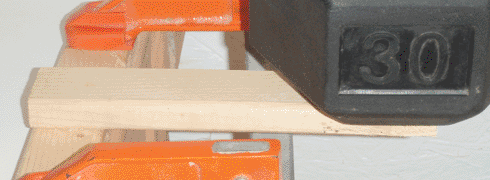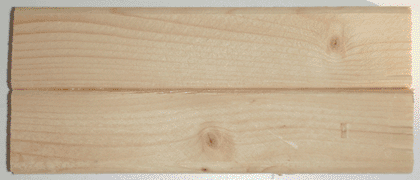

Hide glue is one of the world's oldest adhesives, and is simply made by boiling animal hides in water to extract the collagen, then drying the gelatinous product. Interestingly, food-grade gelatine is the exact same material but cheaper, available in grocery stores, and available in small quantities. Since hide glue offers a number of advantages over normal wood glue (high strength, reversibility, variable characteristics with additives), I decided to experiment with gelatine to determine if it could be used for this purpose.
I began by adding gelatine powder and distilled water to a small beaker in a 1:3 ratio by weight. The gelatine quickly absorbed the water, and once it had become a translucent paste I used my hot plate to warm the mixture to 60°C, forming a thick, slippery glue. I then used a small brush to apply the glue to two different wooden joints: one with the grain perpendicular, and another with the grain parallel, both of which can be seen at the top of the page. The glue sets quickly so no clamping was needed, but I let the joints dry overnight to ensure they were fully cured before testing. By the next afternoon, both joints were dry and felt extremely solid, and I was unable to separate either by hand. As a further demonstration of the glue's strength, I used the T-shaped joint as a shelf to support a 30lb weight, which it accomplished without issue.
Gelatine can also be used as a grain sealer, commonly known as glue size, if the water ratio is increased to 1:20. When painted onto wood at this concentration, it forms an invisible layer in the pores of the wood, which stops subsequent coatings from sinking below the surface. While this is counter-productive in the case of boiled linseed oil (which works by soaking in), I have found it to be highly beneficial when coating wood with varnish.
Interestingly, this glue can be made waterproof by replacing some or all of the water content with wood stain. Since gelatine is made insoluble by trivalent metals, the fresh (divalent) ferrous acetate in the stain solution has no effect on it, but cross-links the proteins as the glue dries and oxidizes. Unfortunately, this leaves behind acetic acid which weakens the glue, so the water resistance is inversely proportional to the glue strength. Furthermore, this glue must be used quickly, since it tends to oxidize at the surface and form a skin. In general this is a fairly primitive solution, and for a more versatile waterproof glue which does not discolor the wood, casein can be used instead.